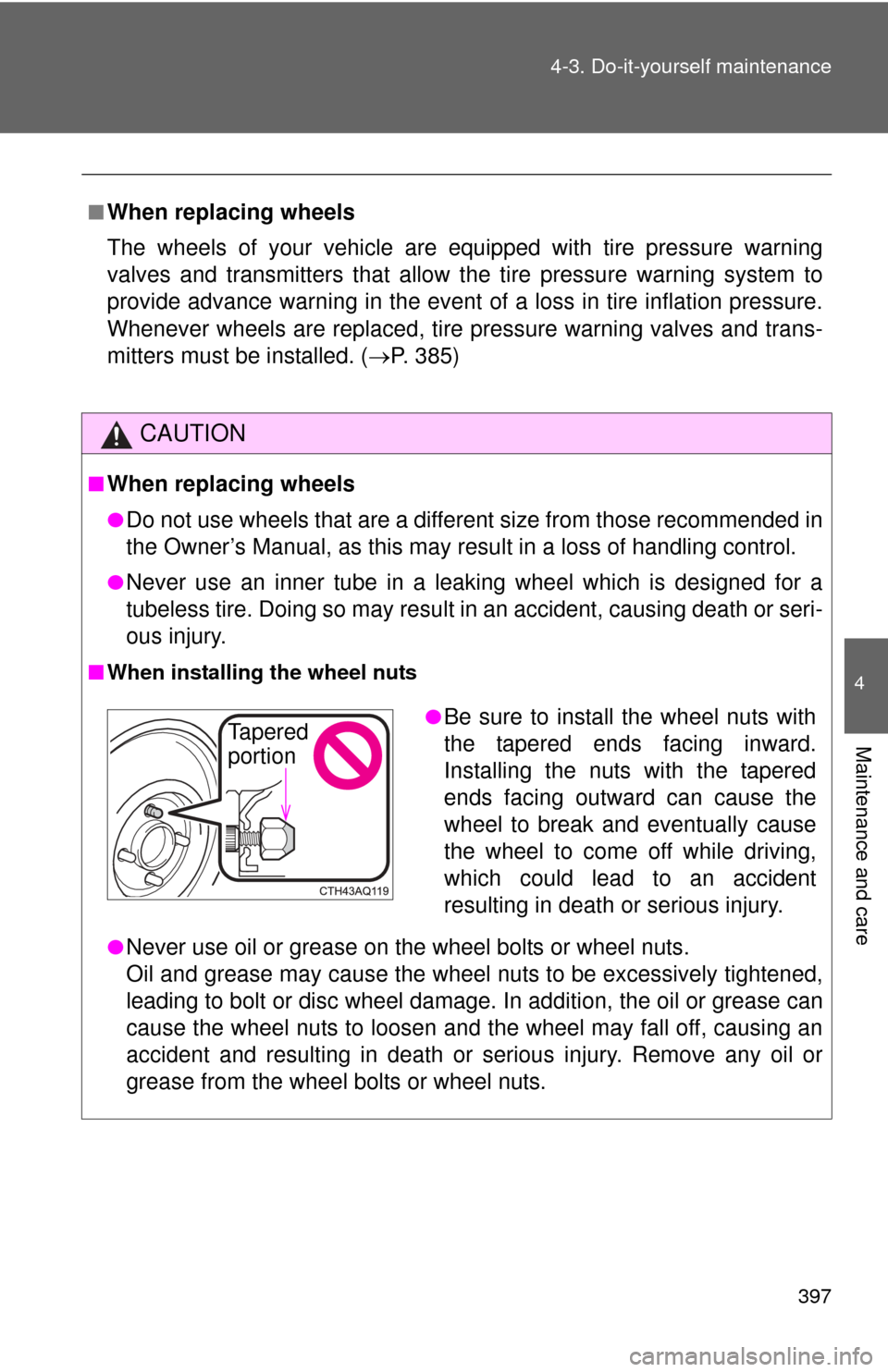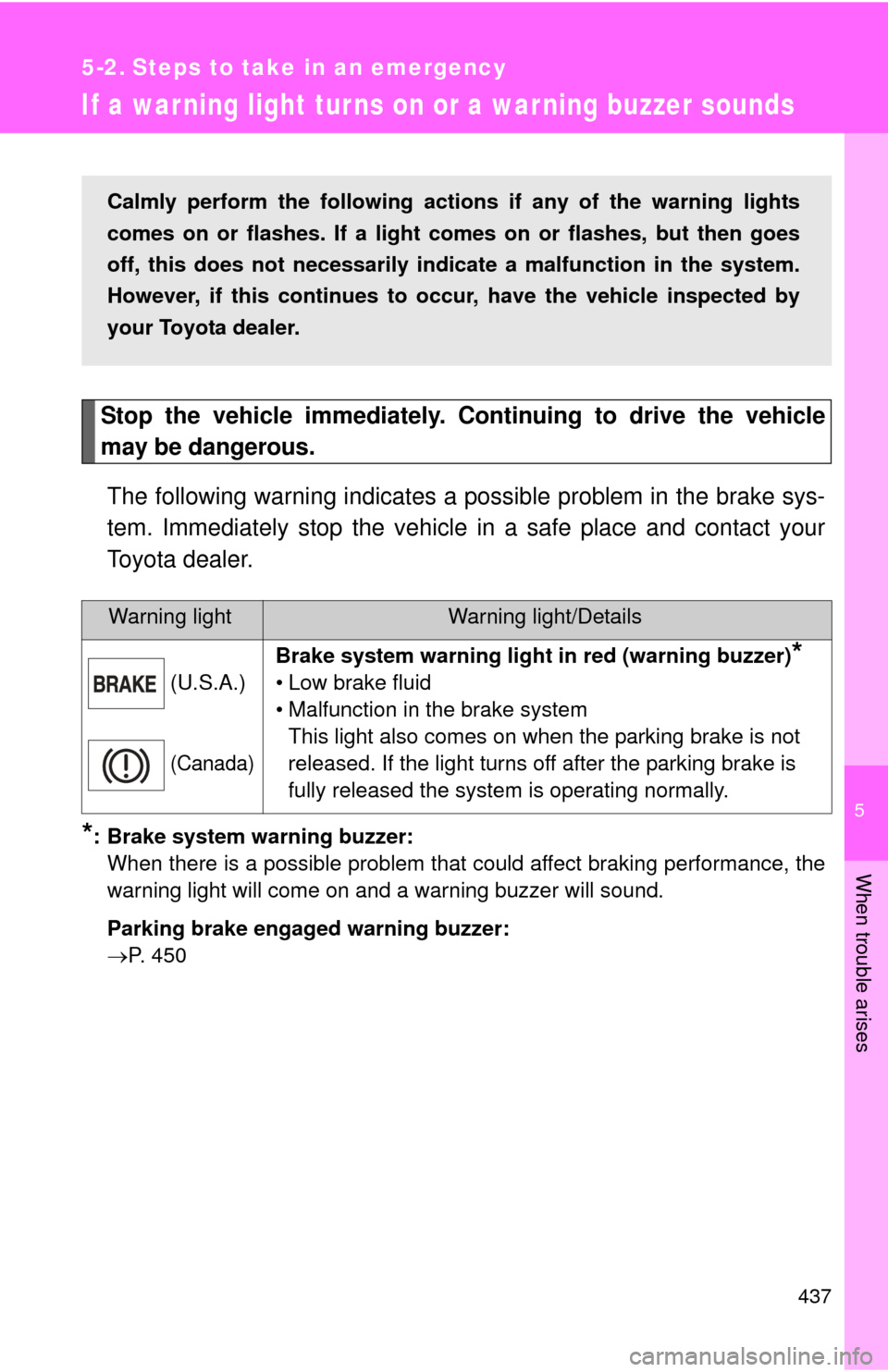Page 394 of 563

391
4-3. Do-it-yourself maintenance
4
Maintenance and care
NOTICE
■Repairing or replacing tires, wheels, tire pressure warning valves,
transmitters and tire valve caps
●When removing or fitting the wheels, tires or the tire pressure warning
valves and transmitters, contact your Toyota dealer as the tire pres-
sure warning valves and transmitters may be damaged if not handled
correctly.
●When replacing tire valve caps, do not use tire valve caps other than
those specified. The cap may become stuck.
■To avoid damage to the tire pressure warning valves and transmit-
ters
When a tire is repaired with liquid
sealants, the tire pressure warning
valve and transmitter may not operate properly. If a liquid sealant is
used, contact your Toyota dealer or other qualified service shop as soon
as possible. Make sure to replace the tire pressure warning valve and
transmitter when replacing the tire. ( P. 385)
■Driving on rough roads
Take particular care when driving on roads with loose surfaces or pot-
holes.
These conditions may cause losses in tire inflation pressure, reducing
the cushioning ability of the tires. In addition, driving on rough roads may
cause damage to the tires themselves, as well as the vehicle’s wheels
and body.
■Low profile tires (vehicles with P195/50R16 tires)
Low profile tires may cause greater damage than usual to the tire wheel
when sustaining impact from the road surface. Therefore, pay attention
to the following:
●Be sure to use proper tire inflation pressure. If tires are under-inflated,
they may be damaged more severely.
●Avoid potholes, uneven pavement, curbs and other road hazards. Fail-
ure to do so may lead to severe tire and wheel damage.
■If tire inflation pressure of each tire becomes low while driving
Do not continue driving, or your tires and/or wheels may be ruined.
Page 400 of 563

397
4-3. Do-it-yourself maintenance
4
Maintenance and care
■When replacing wheels
The wheels of your vehicle are equipped with tire pressure warning
valves and transmitters that allow the tire pressure warning system to
provide advance warning in the event of a loss in tire inflation pressure.
Whenever wheels are replaced, tire pressure warning valves and trans-
mitters must be installed. (
P. 385)
CAUTION
■When replacing wheels
●Do not use wheels that are a different size from those recommended in
the Owner’s Manual, as this may resu lt in a loss of handling control.
●Never use an inner tube in a leaking wheel which is designed for a
tubeless tire. Doing so may result in an accident, causing death or seri-
ous injury.
■ When installing the wheel nuts
●
Never use oil or grease on the wheel bolts or wheel nuts.
Oil and grease may cause the wheel nuts to be excessively tightened,
leading to bolt or disc wheel damage. In addition, the oil or grease can
cause the wheel nuts to loosen and the wheel may fall off, causing an
accident and resulting in death or serious injury. Remove any oil or
grease from the wheel bolts or wheel nuts.
●Be sure to install the wheel nuts with
the tapered ends facing inward.
Installing the nuts with the tapered
ends facing outward can cause the
wheel to break and eventually cause
the wheel to come off while driving,
which could lead to an accident
resulting in death or serious injury.Tapered
portion
Page 401 of 563
398 4-3. Do-it-yourself maintenance
NOTICE
■Replacing tire pressure warning valves and transmitters
●Because tire repair or replacement may affect the tire pressure warn-
ing valves and transmitters, make sure to have tires serviced by your
Toyota dealer or other qualified service shop. In addition, make sure to
purchase your tire pressure warning valves and transmitters at your
Toyota dealer.
●Ensure that only genuine Toyota wheels are used on your vehicle.
Tire pressure warning valves and transmitters may not work properly
with non-genuine wheels.
Page 413 of 563
410 4-3. Do-it-yourself maintenance
25 ECU-B NO.2 7.5 AAir conditioning system, gauge
and meters, occupant classifica-
tion system, tire pressure warning
system, starter system, smart key
system, power door lock system
26 AM2 7.5 A Starter system
27 STRG LOCK 20 A Starter system
28 ABS NO.2 10 A Brake system
29 IGCT-MAIN 30 A IGCT NO.2, IGCT NO.3, IGCT
NO.4, PCU, BATT FAN
30 D/C CUT 30 A DOME, ECU-B NO.1
31 PTC HTR NO.1 30 A PTC heater
32 PTC HTR NO.2 30 A PTC heater
33 FAN 30 A Electric cooling fan
34 PTC HTR NO.3 30 A PTC heater
35 DEF 30 A MIR HTR, rear window defogger
36 DEICER 20 A No circuit
37 BATT FAN 10 A Battery cooling fan
38 IGCT NO.2 10 A Hybrid system
39 IGCT NO.4 10 A Hybrid system
40 PCU 10 A Hybrid system
41 IGCT NO.3 10 A Hybrid system
42 MIR HTR 10 A Outside rear view mirror defoggers
FuseAmpereCircuit
Page 415 of 563
412 4-3. Do-it-yourself maintenance
Under the driver’s side instrument panel
FuseAmpereCircuit
1 TAIL 10 A Parking lights, side marker lights,
tail lights, license plate lights, front
fog lights, gauge and meters
2 PANEL 5 A Instrument panel lights
3 DOOR R/R 20 A Rear power window (right side)
4 DOOR P 20 A Front power window (right side)
5 ECU-IG NO.1 5 A Rear window defogger, tire pres-
sure warning system, main body
ECU, brake system, vehicle stabil-
ity control system, power door lock
system, smart key system
6 ECU-IG NO.2 5 A Electric power steering system
7HTR-IG 7.5 A Air conditioning system, PTC
heater
8 GAUGE 10 A Back-up lights, audio system, shift
lock control system, moon roof,
vehicle control and operation data
recording, vehicle proximity notifi-
cation system
9 WASHER 15 A Windshield wipers and washer
10 WIPER 25 A Windshield wipers and washer
11 WIPER RR 15 A Windshield wipers and washer
12 P/W 30 A Power window
Page 430 of 563
When trouble arises5
427
5-1. Essential informationEmergency flashers ......... 428
If your vehicle needs to be towed ........................ 429
If you think something is wrong ......................... 436
5-2. Steps to take in an emergency
If a warning light turns on or a warning buzzer
sounds ........................... 437
If a warning message is displayed........................ 447
If you have a flat tire......... 463
If the hybrid system will not start .......................... 475
If the shift lever cannot be shifted from P............ 477
If you lose your keys ........ 478
If the electronic key does not operate properly....... 479
If the vehicle 12-volt battery is discharged ...... 481
If your vehicle overheats ....................... 487
If the vehicle becomes stuck .............................. 492
If your vehicle has to be stopped in an
emergency ..................... 493
Page 432 of 563
5
When trouble arises
429
5-1. Essential information
If your vehicle needs to be towed
Situations needs to contact dealers before towingThe following may indicate a problem with your transmission. Contact
your Toyota dealer before towing.
● A warning message for the hybrid system is shown on the multi-
information display and the vehicle does not move.
● The vehicle makes an abnormal sound.
If towing is necessary, we recommend having your vehicle towed by
your Toyota dealer or a commerci al towing service, using a lift-type
truck or flatbed truck.
Use a safety chain system for all to wing, and abide by all state/pro-
vincial and local laws.
If towing your vehicle with a wheel- lift type truck from the front, the
vehicle's rear wheels and axles must be in good conditions.
( P. 430, 434)
If they are damaged, use a towing dolly or flatbed truck.
Page 440 of 563

5
When trouble arises
437
5-2. Steps to take in an emergency
If a war ning light turns on or a war ning buzzer sounds
Stop the vehicle immediately. Continuing to drive the vehicle
may be dangerous.The following warning indicates a possible problem in the brake sys-
tem. Immediately stop the vehicle in a safe place and contact your
Toyota dealer.
*: Brake system warning buzzer: When there is a possible problem that could affect braking performance, the
warning light will come on and a warning buzzer will sound.
Parking brake engaged warning buzzer:
P. 450
Warning lightWarning light/Details
(U.S.A.)
(Canada)
Brake system warning light in red (warning buzzer)*
• Low brake fluid
• Malfunction in the brake system This light also comes on when the parking brake is not
released. If the light turns off after the parking brake is
fully released the system is operating normally.
Calmly perform the following actio ns if any of the warning lights
comes on or flashes. If a light comes on or flashes, but then goes
off, this does not necessarily indicate a malfunction in the system.
However, if this continues to o ccur, have the vehicle inspected by
your Toyota dealer.